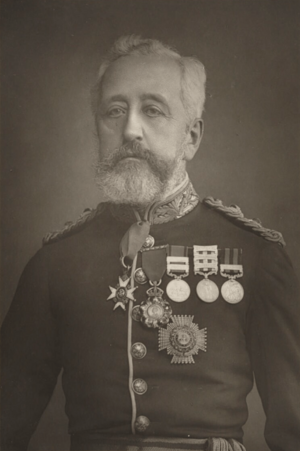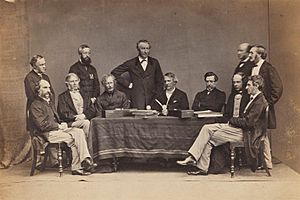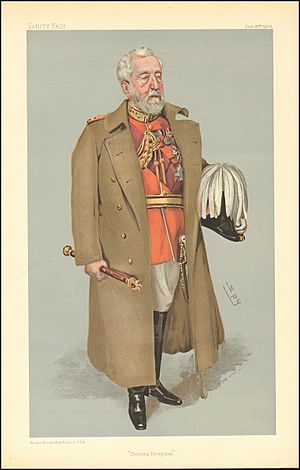Henry Wylie Norman facts for kids
Quick facts for kids
Sir Henry Norman
|
|
|---|---|
 |
|
| 7th Governor of Queensland | |
| In office 1 May 1889 – 31 December 1895 |
|
| Monarch | Queen Victoria |
| Premier | Boyd Dunlop Morehead Samuel Griffith Thomas McIlwraith Hugh Nelson |
| Preceded by | Anthony Musgrave |
| Succeeded by | Lord Lamington |
| Governor of Jamaica | |
| In office 27 October 1883 – April–May 1889 |
|
| Monarch | Queen Victoria |
| Preceded by | Anthony Musgrave Somerset Wiseman-Clarke (acting) Dominic Jacotin Gamble (acting) |
| Succeeded by | William Clive Justice (acting) Henry Arthur Blake |
| Personal details | |
| Born | 2 December 1826 London, Middlesex, England |
| Died | 26 October 1904 (aged 77) London, Middlesex, England |
| Resting place | Brompton Cemetery, London |
| Military service | |
| Allegiance | |
| Branch/service | |
| Years of service | 1844–1904 |
| Rank | Field Marshal |
| Battles/wars |
|
| Awards | |
Field Marshal Sir Henry Wylie Norman (born December 2, 1826 – died October 26, 1904) was an important British soldier and leader. He served in the British Indian Army, which was the army of British India.
He took part in several important conflicts. These included the Second Anglo-Sikh War and the Indian Rebellion of 1857, also known as the Indian Mutiny. Later, he became a key government official in India. He was like a Minister for War. After his military career, he became a colonial administrator. He served as the Governor of Jamaica and then the Governor of Queensland in Australia.
Contents
Early Life and Beginnings

Henry Norman was born in London, England. He was the oldest of ten children. His father, James Norman, was a merchant. The family business was mostly in Cuba before they moved to Calcutta, India.
In 1842, Henry joined his family's business in Calcutta. But he wanted to be a soldier. He convinced his father to let him join the Bengal Army.
Military Career and Brave Deeds
Henry Norman started his army career in 1844. He joined the 1st Bengal Native Infantry. He was later transferred to another unit. In 1846, he was sent to Lahore.
He fought in the Second Anglo-Sikh War in 1848 and 1849. He took part in major battles like the Battle of Ramnagar and the Battle of Gujrat. His bravery caught the eye of his commander, Sir Colin Campbell.
A Daring Rescue
In 1850, Norman joined an expedition against the Afridi people. During this mission, he showed great courage. A group of soldiers was under attack. Four wounded men were stuck high up on a mountain.
Norman, along with another officer and some brave soldiers, climbed the dangerous rocks. They went under enemy fire to rescue the injured men. This act of heroism was praised by his superiors.
Key Conflicts and Promotions
Norman continued to serve in many frontier expeditions. He also helped put down the Santhal rebellion from 1855 to 1856. In 1856, he became an assistant adjutant general in India.
During the Indian Rebellion of 1857, he was very active. He was present at important events like the Siege of Delhi and the Siege of Lucknow. He was recognized for his service.
He received several promotions over the years. By 1870, he was a lieutenant colonel. He then became the military member of the Governor-General's Council. This role was like being the Minister for War in India. In this position, he made sure that the Indian Army had fewer weapons than the British troops. This was to prevent another rebellion.
In 1878, he returned to London. He became a member of the Council of India. By 1882, he was a full general and retired from active military service.
Life as a Governor
In 1883, Sir Henry Norman became the Governor of Jamaica. He helped introduce a new constitution there. This change aimed to limit the power of local leaders.
In 1889, he moved to become the Governor of Queensland in Australia. His job was to reduce government spending. However, he managed to work well with local politicians and people. They were impressed by his skills.
He was even offered the job of Viceroy of India in 1893, which was a very high position. But he turned it down. He left Queensland in 1895 and went back to London.
In his later years, he became the governor of the Royal Hospital Chelsea in 1901. This is a home for retired soldiers. In 1902, he was promoted to field marshal, the highest rank in the British Army. He also helped investigate the military preparations for the Second Boer War.
Sir Henry Norman passed away on October 26, 1904, at the Royal Hospital Chelsea. He was buried in Brompton Cemetery. A memorial to him can be found in St Paul's Cathedral in London.
Family Life
Sir Henry Norman was married three times. His first wife was Selina Eliza Davidson. They married in India in 1853 and had three daughters. Selina passed away in 1862.
In 1864, he married Jemima Anne Temple, a widow. Sadly, she died the following year. In 1870, he married Alice Claudine Sandys. They had two sons and one daughter.
Children of Henry Wylie Norman and Selina Eliza Davidson
- Mary Lucy Norman (born 1854)
- Hellen Campbell Norman (born 1856)
- Annie Forde Norman (born 1857)
Children of Henry Wylie Norman and Alice Claudine Sandys
- Walter Henry Norman (born 1871)
- Claude Lumsden Norman (born 1876)
- Grace Alice Norman


